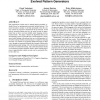Free Online Productivity Tools
i2Speak
i2Symbol
i2OCR
iTex2Img
iWeb2Print
iWeb2Shot
i2Type
iPdf2Split
iPdf2Merge
i2Bopomofo
i2Arabic
i2Style
i2Image
i2PDF
iLatex2Rtf
Sci2ools
GECCO
2005
Springer
2005
Springer
Constructing good learners using evolved pattern generators
Self-organization of brain areas in animals begins prenatally, evidently driven by spontaneously generated internal patterns. The neural structures continue to develop postnatally when the sensory systems are exposed to stimuli from the environment. In this process, prenatal training may give the neural system the appropriate bias so that it can learn reliably under changing environmental stimuli. This paper evaluates the hypothesis that an artificial learning system can benefit from a similar approach, consisting of initial training with patterns from an evolved generator followed by training with the actual training set. Competitive learning networks were trained in recognizing handwritten digits in three ways: through environmental learning only, through evolution only, and through prenatal training with evolved pattern generators followed by environmental learning. The results demonstrate that the evolved pattern generator approach leads to better learning performance, suggestin...
| Added | 27 Jun 2010 |
| Updated | 27 Jun 2010 |
| Type | Conference |
| Year | 2005 |
| Where | GECCO |
| Authors | Vinod K. Valsalam, James A. Bednar, Risto Miikkulainen |
Comments (0)

